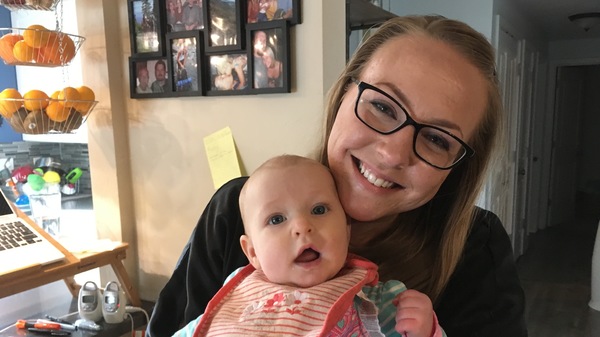 JEFFERSON CITY, Mo.: Sixty days after giving birth, women with health insurance through Show-Me Healthy Babies and MO HealthNet lose their postpartum coverage.
JEFFERSON CITY, Mo.: Sixty days after giving birth, women with health insurance through Show-Me Healthy Babies and MO HealthNet lose their postpartum coverage.
For women who received substance use treatment through their coverage while pregnant, the risk of relapse and overdose increases.
Matt Stinson, a family physician and vice president of medical and behavioral health at the Jordan Valley Community Health Center in Springfield, has seen firsthand the cost of the limited 60-day coverage.
The center had a patient who was high each time she came in for an appointment during her first pregnancy. Her second pregnancy was different. She got counseling and no longer needed medication-assisted treatment, which reduces withdrawal symptoms and decreases the chance of relapse.
After having her baby, she said she was struggling and that she once again needed help. The center was able to get her counseling but was not able to give her medication-assisted treatment due to her expired coverage.
She went home that night and died of a heroin overdose.
The Columbia Missourian reports that Missouri ranks 42nd in maternal mortality in the U.S.
In 2017, Missouri’s maternal mortality rate was 32.6 per 100,000 live births, up from 28.5 in 2016. The 2017 national average was 20.7, according to the Centers for Disease Control.
The Missouri Department of Mental Health served 1,009 pregnant women in substance use treatment during the 2017 fiscal year. Of those women, 35 percent had an opioid use disorder according to Debra Walker, director of public and legislative affairs for the Missouri Department of Mental Health.
Although women receive substance abuse treatment while they’re pregnant, it’s easy for them to relapse after giving birth, when they are no longer covered.
“A lot of it’s about access,” said Rep. Martha Stevens, D-Columbia. “These are vulnerable women, being low-income and not having access to health care.”
When these women do relapse, they are more likely to overdose due to a decrease in tolerance that occurred while they were in treatment and not using during their pregnancy, said Jaye Shyken, associate professor of obstetrics, gynecology and women’s health at St. Louis University and the medical director of the Women and Infant Substance Help Center.
The ideal coverage period would be one or two years after the end of the pregnancy, Shyken said. With the help of medication-assisted treatment, these women would be less likely to relapse after that period.
“The longer the better,” Shyken said. “Current thinking about opioids is that this is a brain disease, and it takes quite a while for the brain to sort of readapt. They never reach normality, but they can get closer to normality.”
One of the criticisms of medication-assisted treatment is that it’s replacing one drug with another. Shyken argued that diabetics are dependent on insulin, and people who are hypertensive are dependent on medication as well.
“Medication-assisted treatment during pregnancy results in the reduction not only in the use of illegal opioids, but also all medications and abuse substances,” Shyken said.
Even if legislation were passed that would help women pay for it, some rural communities lack the other necessary resources to provide medication-assisted treatment, said Dina van der Zalm of the Missouri Rural Crisis Center.
One in seven women in Missouri suffer from postpartum depression – but in the Medicaid population it’s one in five, said Cynthia Rogers, child and perinatal psychiatrist at Washington University and director of the Perinatal Behavioral Health Service.
“Both postpartum mental health disorders and postpartum substance abuse disorders are fatal,” Rogers said. “If you want to effectively treat postpartum substance use disorders, you have to have access to mental health treatment.”
Suicide is one of the leading complications of pregnancy. The risk of suicide in the postpartum period spikes at four and twelve months after giving birth, showing a need for coverage that extends past 60 days, Rogers said.
Between 2006 and 2016, the number of infants born with neonatal abstinence syndrome increased by 538 percent, according to the Missouri Hospital Association. The syndrome occurs when an infant is born with withdrawal symptoms as a result of opioid use by the mother during pregnancy.
Opioids are not the only substances that pose a threat to infants or mothers. Shyken cited the consumption of tobacco, alcohol and narcotics as some of the substances that increase the risks for low birth weight, mental retardation, cardiac abnormalities and other signs in infants.
“It’s incumbent upon us to do what we can to try and support them, as opposed to some other approaches that might seek to criminalize moms who have babies with neonatal abstinence syndrome or that are born with substance use-related complications,” said Rep. Cora Faith Walker, D-St. Louis. Walker has proposed House Bill 1616 to extend Show-Me Healthy Babies coverage for substance abuse treatment up to a year after the end of a pregnancy.
Missouri’s infant mortality rate – 6.5 per 1,000 live births in 2016 – is above the national average of 5.9, according to the Centers for Disease Control.
Half of the infant mortality rate is accounted for by neonatal mortality, the loss of an infant within the first 28 days of life, Shyken said.
“Mother and infant health are inextricably linked,” Shyken said.
One of the reasons Walker decided to propose her bill was because of the high infant mortality rates in her district. In parts of St. Louis County, the infant mortality rate was over 16 deaths per 1,000 live births, according to Missouri Department of Health and Senior Services data from 2009-2013.
The rate in those areas was higher than in Syria, where it was 14.8 deaths per 1,000 live births in 2017, according to the CIA.
“Something needed to be done,” Walker said.-AP







